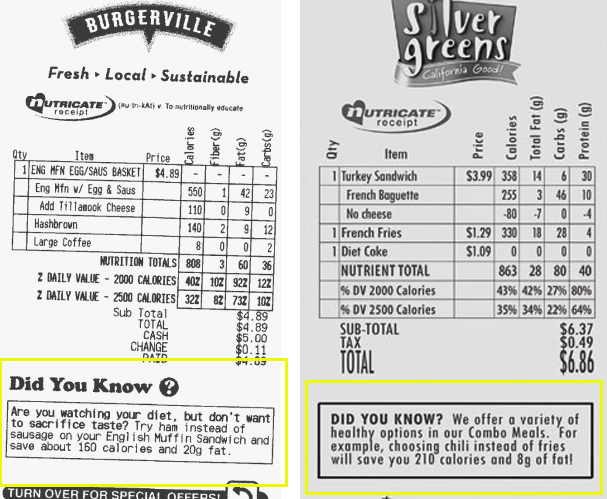Restaurant Receipts Now Tell You What You Should Have Eaten Instead

A study shows that putting these helpful hints on receipts convinces customers to make substitutions, but has little impact on total calorie and fat intake.
The Nutricate receipt from the folks at SmartReceipt not only reminds you of all the calories, fats, and carbs you probably paid too much for, it also includes a helpful little “Did you know?” box to mention less unhealthy options than what you ordered.
“Did you know? Holding the mayo on your sandwich will save you 150 calories and 10 grams of fat?” reads one potential message on the Nutricate receipt, which unlike your obnoxious friend, you can easily (and legally) crush and discard.
The Nutricate (even the name sounds like some sort of horrid, powdery fad dietary supplement) has been tested at two West Coast chains, Burgerville and Silvergreens. And this recent study of the data from a two-year test at the former chain seems to indicate that it is indeed changing what some customers order.
“We find that customers, in the aggregate, made most of the item substitutions that were encouraged by the messages, such as substituting ham for sausage in a breakfast sandwich, or substituting frozen yogurt for ice cream, though effects on overall calories and fat consumed were small,” reads the report, which does recognize two significant limits to receipt-based nutrition information — “it relies on consumer memory and can only affect consumption on future restaurant visits.”
The researchers claim that the very specific, but simply stated information on the Nutricate receipt helps customers to remember the advice for future visits. They say this may be more helpful for some consumers than the menu board nutrition info currently being introduced around the country.
The menu boards generally provide calories totals of the as-advertised item, so the customer doesn’t always know that there can be subtractions from the food item that could have a significant impact on the nutritional value. But if the customer is told afterward, “Hey, buddy… ditch the special sauce and save 80 calories,” they may be more likely to remember that going forward.
“[W]e hypothesize that simple suggestions to make a health-improving switch from something the consumer recently chose to a close substitute may circumvent many of the cognitive difficulties associated with making choices from lists, such as menus,” write the researchers.
That said, during the two years during which dozens of Burgerville restaurants were successfully convincing customers to substitute side salads for fries, or grilled chicken for fried chicken, these changes ultimately had little effect on the calories or fat consumed.
“One possible explanation is that customers made other item substitutions that counteract the [more healthy] substitutions,” reads the report. “Second, several of the encouraged items (whose consumption rose substantially in percentage terms when Nutricate receipts were introduced) constitute a very small share of fast-food purchases. Examples include side salads, kids’ apples and grilled chicken sandwiches. Even large substitutions towards items like these will have only minimal effects on total fat and calories purchased.”
Restaurants Are Calorie-Shaming Diners on Receipts Now [Eater.com]
Would You Hold the Mayo If the Receipt Suggested It? [Bloomberg]
Want more consumer news? Visit our parent organization, Consumer Reports, for the latest on scams, recalls, and other consumer issues.

